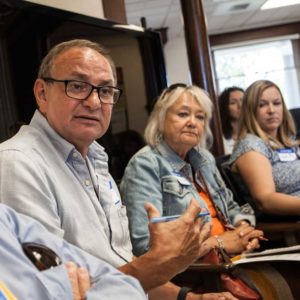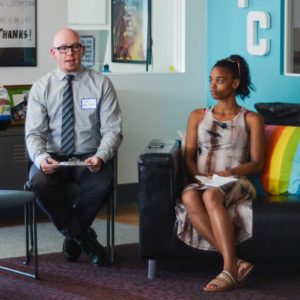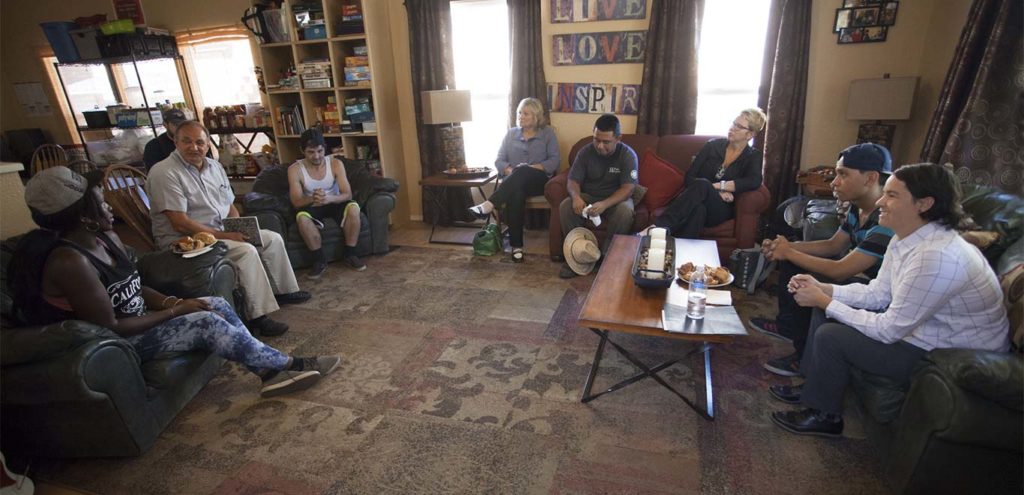By Sheila Babb Anderson
A Way Home Washington recently embarked on a listening tour around Washington state to hear from local leaders about the state of youth and young adult homelessness in their communities. Each conversation was led by our honorary co-chair, First Lady Trudi Inslee, and Kim Justice, Executive Director of the Office of Homeless Youth. The conversations included service providers, school officials, housing providers and local leaders. In each stop we asked participants the following questions:
- What does youth homelessness look like in your community?
- What is working well to prevent and end youth homelessness?
- What else do you need to be successful?
In separate conversations, youth with experiences of homelessness were given the opportunity to share their stories and feedback. A Way Home Washington’s youth co-chair moderated the conversation with young people in Everett, and highlighted how important youth voice is in this work.
Four communities participated in this initial series of listening sessions: Yakima, Tacoma, Vancouver, and Everett. The sessions were hosted by key service providers in each community, who issued the invitations to other individuals and entities working with youth and young adults.
Universal Feedback
While it is clear that each community has its own unique bright spots and challenges, there were a few common things heard in each city:
- The need for safe spaces for youth under the age of 18. Leaders in each community talked about the challenges assisting unaccompanied youth under 18. Increased shelter options, better relationships with child welfare, and host homes are some of the solutions being considered. Housing options are particularly challenging in rural areas, where provider capacity continues to be a major issue.
- Lack of affordable housing. Housing shortages in each community are not only driving up the numbers of overall homelessness, but youth homelessness, as well. Youth and young adults are particularly hindered in their search for housing due to lack of credit and rental history, inconsistent employment, or criminal records as a result of their homelessness.
- Community collaboration is key. Each community highlighted successful partnerships between schools, housing, and workforce partners. However, more is needed to break down silos and foster better collaboration between systems interacting with youth.
- More can be done to build awareness. Youth homelessness is often hidden and misunderstood. Honest and open conversations are needed to address this problem head-on.
Many other issues were addressed in these discussions, with varying levels of urgency, including:
- Struggles with mental health and chemical dependency
- Challenges faced by young parents
- Relationships with law enforcement and criminalization of homelessness
- Human trafficking
Four Communities Working on Solutions
Yakima – August 16, 2016
In Yakima, Rod’s House and Yakima Neighborhood Health Services convened the conversation at The Space, a LGBTQ drop in center that opened in June. The Space acts as a hub for services—a key ingredient for success. In addition to The Space, Yakima youth can also use Rod’s House as a central location for referrals to housing, healthcare, job training, and other basic needs.
Yakima Neighborhood Health Services also shared their success with the BESTY House, a new partnership between YNHS, Rod’s House, the South Central Workforce Council and Educational Service District 105. These diverse partners are coming together to provide a supportive living environment for young women transitioning from extended foster care to independent living. This group living situation will provide housing, job coaching and education plans to set these youth on the path to successful adulthood.
Tacoma – August 24, 2016
The Tacoma listening session took place at the Oasis Youth Center, in partnership with Community Youth Services. For over 30 years, the Oasis Youth Center has provided safe spaces for LGBTQ youth in Pierce County. With an estimated 40% of youth and young adults experiencing homelessness identifying as LGBTQ, resources like Oasis will play a critical role in the identification and response to this community.
Community Youth Services, a long time service provider in the South Sound region, is working in partnership with the Tacoma Housing authority to site a new young adult specific housing shelter in Pierce County through a grant from the U.S. Department of Housing and Urban Development. This shelter will house 33 young people, ages 18-24, and provide them with services appropriate to that age group.
Vancouver – September 21, 2016
In Vancouver, Janus Youth Services hosted the community conversation with the City of Vancouver. Janus Youth Services provides youth focused housing and a drop in center in Vancouver, with plans to expand their work to Cowlitz County in the near future.
The Vancouver community also highlighted their school based work around the identification and assistance to homeless families and unaccompanied youth in the Vancouver School District. Their success is centered on family resource coordinators located in schools and will be expanded through a recent grant from the State of Washington under the Homeless Student Stability Act, which passed earlier this year.
Everett – September 22, 2016
The last stop on the tour was hosted by Cocoon House in Everett. As a major youth provider in Snohomish County, Cocoon House has formed strong relationships with the schools and workforce community to get young people on a path out of homelessness through education and employment. According to Workforce Snohomish, 80% of the youth visiting their drop-in center identify as homeless.
This community highlighted the importance of building trust between partners in this work. Service providers and school employees need to work together for quick referrals and interventions. This isn’t the case in every community, but a key element to success.
Each community visited on the listening tour has found ways to respond to the unique strengths and challenges they face. Each community can share lessons around collaboration on housing, schools, employment and other services key to preventing and ending youth homelessness.

 the expanding crisis of youth and young adult homelessness. Our task now is to ensure every community has the awareness, information and support needed to take action.”
the expanding crisis of youth and young adult homelessness. Our task now is to ensure every community has the awareness, information and support needed to take action.” services from
services from 